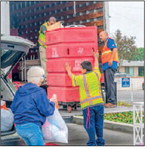Service level drives staa compensation and the GRF assessment
MESSAGE FROM THE GRF TREASURER
by Nick Massetti
GRF Treasurer
Budgeted employee wages and benefits are the single largest contributor to the GRF monthly assessment. They represent about 60% of the total expenses in the GRF annual budget. Last week the number and type of GRF employees was presented. Now presented are the actual budgeted expenses associated with them within the context of the overall budgeted expenses that determine the GRF assessment.
These are shown in the table to the right. First of all, the wages and benefits related expenses have held steady at about 61% of total expenses until the 2025 budget when it dropped to 54%.
For the often-quoted time period from the 2022 budget to the 2025 budget, employment related expenses have risen by 37.8%. Most of that was related to catchup adjustments in 2023 and 2024 to correct for many years of stagnated wages, which had ballooned employee turnover.
On the other hand, total expenses have risen by 47.4% over those four budgets. The additional amount was because of an almost $2 million jump in the 2025 budget, which was due to the addition of two years’ worth of insurance premium increases. The 2024 budget had underestimated the surprise year-end premium increase.
The impact of steadily rising expenses has had its expected impact on the GRF assessment. From the 2022 budget to the 2025 budget the GRF monthly assessment has grown from $172 to $235 or by 36.6%.
What has blunted the impact of the faster growing total expenses is an even faster growing “other income” category. GRF derives this offsetting income from many sources including rental income from the Health Care Center, the On-Site Sales office and the Nuvision Credit Union. By far the largest source of income is the Trust Property Use Fee that is paid by each new GRF Member. GRF has found ways to grow that offsetting income by 76.7%, from $5 million in the 2022 budget to $8.9 million in the 2025 budget. Without that income the GRF monthly assessment would have been $113 higher.
So, there you have it. Straight out of published budget reports. The assessments are a delicate balance between what residents can afford and what services they can’t afford to lose. Any ideas are welcomed during the budget process that begins in July. Join in.
Wages and benefits have held steady at about 61% of total expenses, until the 2025 budget when it dropped to 54%.




